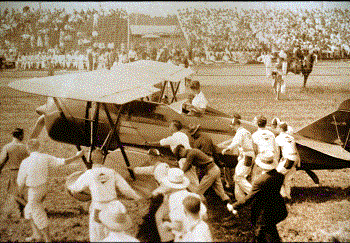Clifford Henderson brought the faltering National Air Races to Los Angeles
Mines Field in September of 1928. He also added an Aeronautical
Exposition to showcase the latest in aircraft and related equipment. The
1928 National Air Race was a major improvement over previous exhibitions
held at non spectator-friendly military air stations. 1929 would be a
quantum leap in quality and a much-needed public exposure of aviation in
general.

In 1929,
Cleveland hosted the National Air Races and Aeronautical Exposition. The
Cleveland Airport was the first municipally owned in the country. It was
large enough to host the races on the west end of the airfield without
interrupting normal commercial traffic at the east end. A state- of -the
-art passenger terminal building had just been opened, complete with
beautiful landscaping. More than a dozen new hangars and support
buildings were either complete or under construction.

The
Aeronautical Exposition was held in the new $10 million Public Hall
in downtown Cleveland. No less than 250 exhibits displayed $3 million in
aircraft, motors and accessories. Musical extravaganzas were offered each
day and evening.

Boeing
Aircraft Company sent it's newest tri-motor Transport, the Model 80 prior
to it's entrance into airline service. Pictured above on display outside
of Cleveland City Hall
On the
day prior to the opening of the races, a very large parade was held on the
main street of downtown Cleveland, with no less than 100 floats, most of
them covered with fresh flowers. Overhead, an armada of military and
civilian aircraft accompanied the parade.


Cleveland City Manager William
Hopkins with Amelia Earhart, Ed Thompson, brother of Charles, and Mrs. Ed
Thompson.
Many
dignitaries and movie stars were in attendance, national hero Charles
Lindbergh and Commander Hugo Eckner of the Graff Zeppelin, to name just
two. Pilot Jimmy Haizlip said "the whole of aviation was there and you
could have put them all in a dance hall and have half of it left over".
The daily schedule included other aviation attractions such as parachute
jumping, military demonstrations, lighter than-air craft, air derbies and
aerobatics demonstrations. Coupled with the Aeronautical Exposition and
concerts, this was a major entertainment spectacle and a much needed
public exposure of military and civilian aviation.

Committee members and airport
Officials gather in front of Richland Oil Company's luxury appointed
Fokker F -10

Start of the Women's Air derby:
Chairman Floyd J. Logan, Louis W. Greve, President of The Cleveland
National Air Races holding the starting gun, with Cliff Henderson in
contact with Clover Field.

Opening of races at Cleveland:
Louise Thaden, flying a borrowed Travel Air, won the Women's Air Derby,
sponsored by the National Exchange Club.

The forty plus trophies on display at the Expo in Public Hall
While the
military dominated the previous National Air Races, this year would be
different. President Walter Beech of the Travel Air Manufacturing Co. in
Wichita had secretly developed a low-wing monoplane with great speed
potential to enter in the free-for-all race. This aircraft was tested
and flown to Cleveland, where Beech had arranged for a private hangar for
his entrants. As soon as the plane landed, it was rolled into the hangar
and the doors closed. The press called it the "Mystery Ship".
On Sept. 2nd, Doug Davis, an
airline pilot from Atlanta, Georgia, flying the Travel Air "Mystery Ship",
won event no. 26, the 50-mile free-for-all speed contest. During the race,
Davis cut inside one of the pylons and had to re-circle it but still
managed to beat both the Army's and Navy's fastest pursuit planes. Charles
Thompson, president of Thompson Products Company, sponsor of the event
personally, awarded the large cup to Doug Davis. Second place went to Lt.
Breen in a Army P-3A. Third place went to Roscoe Turner in a Lockheed
Vega.
Event 26
Winners (Thompson Cup)

The Travel Air "Mystery Ship" License number R614K
Race number 31 Pilot Doug Davis

USAAC P-3A XP-524 Race number 80

Lockheed Vega NC 3354 Race number 192 Pilot Roscoe
Turner
1929
Thompson Cup Race Event No.26 September 2
Cleveland Ohio (5 laps 10 mile course 50 miles Total purse $1500)
|
Place |
Pilot |
Aircraft |
No. |
License No. |
Speed |
| 1 |
Doug Davis |
Travel Air-R |
31 |
R 614 K
|
194.90 |
| 2 |
Lt.
R.G.Breen |
Curtiss P3A |
80 |
XP 524 |
186.84 |
| 3 |
Roscoe
Turner |
LockheedVega |
192
|
NR 7954 |
163.44 |
| 4 |
Comm. J.J.
Clark |
Curtiss
F6C-6 |
210 |
A 7144 |
153.38 |
| 5 |
H.S. Myhres |
Simplex |
71 |
NR 43M |
152.15 |
| 6 |
McConaughey |
Travel Air |
30
|
NR 612K |
145.20 |
| 7 |
C.E. Clark |
Travel Air |
32 |
NR 613K |
N A |
| 8 |
C.D. Bowyer |
Cessna |
53 |
NC 6450 |
DNF |
